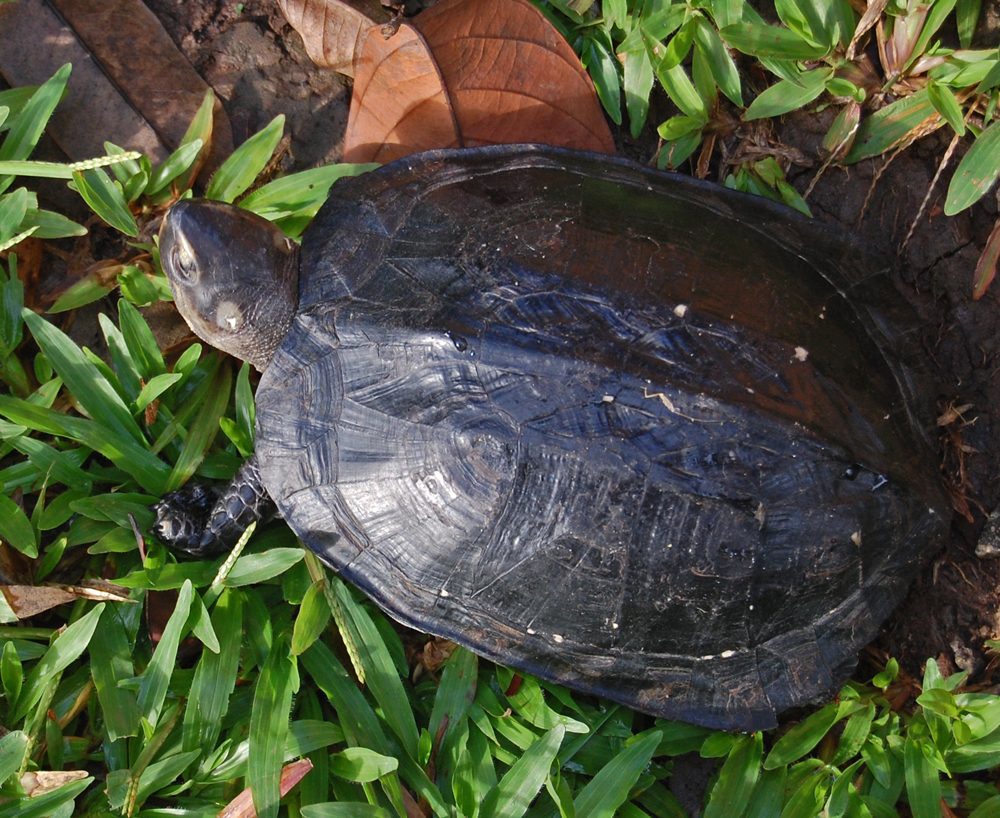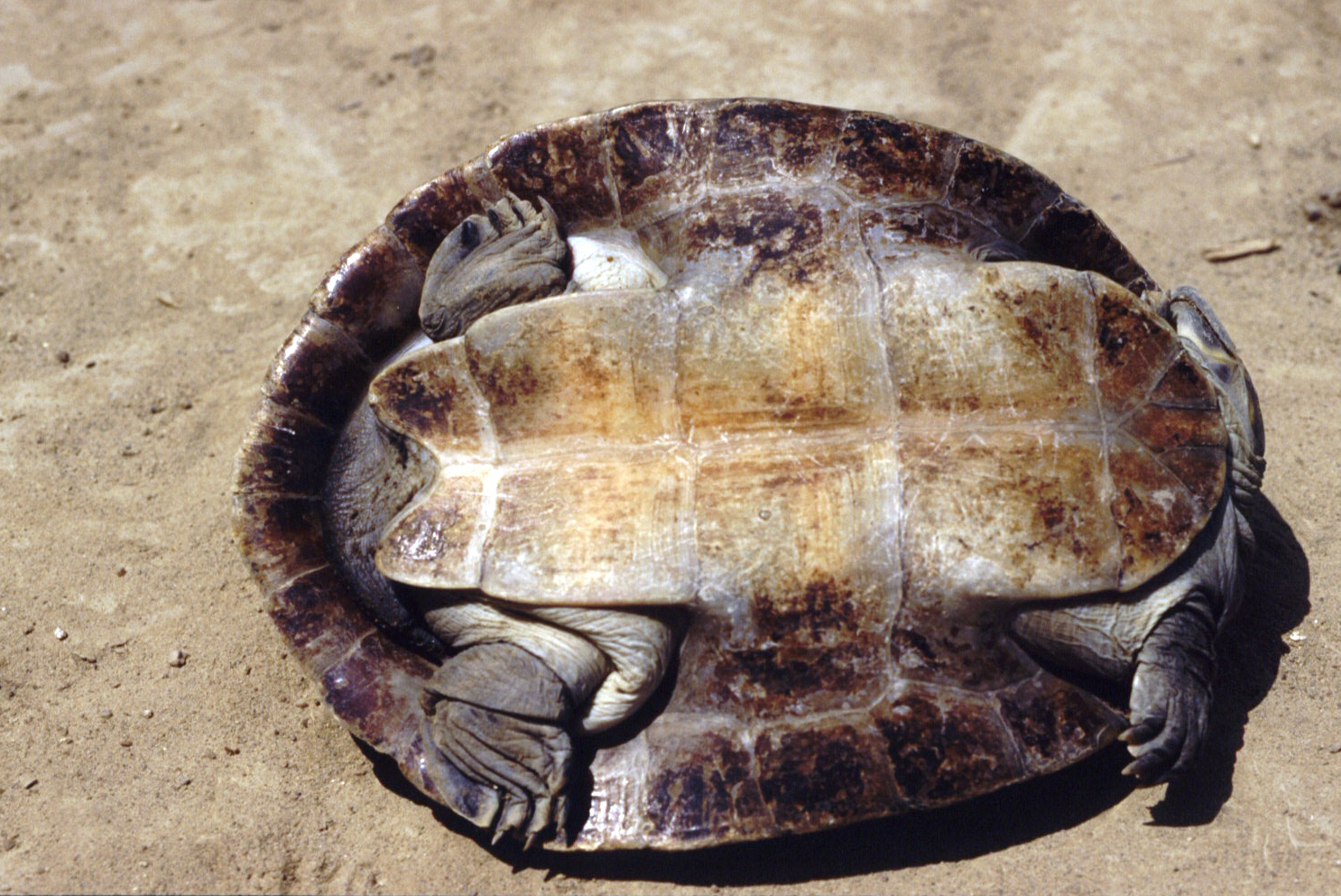|
Smiling Terrapin
''Siebenrockiella crassicollis'' (commonly known as black marsh turtle, smiling terrapin, and Siamese temple turtle, among others) is a freshwater turtle endemic to Southeast Asia. It is one of two species classified under the genus ''Siebenrockiella'' in the family Geoemydidae. Black marsh turtles are small to medium-sized turtles that are almost completely black except for white to yellow markings on the head. They are largely aquatic and prefer slow-moving or still bodies of water with heavy vegetation. Black marsh turtles are also commonly kept as pets and as sacred animals in Southeast Asian Buddhist temples. They are classified as endangered by the IUCN, being one of the several Southeast Asian turtle species heavily exploited for the international wildlife trade, particularly for food and traditional medicine in the Chinese markets. Taxonomy and nomenclature Formerly under the genus ''Emys'', black marsh turtles are now classified under ''Siebenrockiella''. They were fir ... [...More Info...] [...Related Items...] OR: [Wikipedia] [Google] [Baidu] |
Kalyar Platt
Kalyar Platt is a Burmese herpetologist and turtle conservationist. She is the director of the Myanmar Program of the Turtle Survival Alliance and oversees conservation, breeding and reintroduction projects for some of Southeast Asia's rarest turtle species. She formerly worked for Wildlife Conservation Society and earned her PhD from Bangkok's Chulalongkorn University in 2007. Early life and education Kalyar was born in 1972 in Yangon, Myanmar, to U Nyunt Thein and Daw San San. Her father was a government engineer involved in the construction of hydroelectric dams. She accompanied him to work sites where she witnessed construction workers collecting turtles in pits. She was fascinated by the variety of species but recoiled in horror when the turtles were pulled from the pit, butchered and cooked by the camp chef. She earned her B.Sc. with honours from Yangon University in 1995. She earned her M.Sc. from the same university in 2000. Fearing that the Burmese military junta would ... [...More Info...] [...Related Items...] OR: [Wikipedia] [Google] [Baidu] |
Morphology (biology)
Morphology is a branch of biology dealing with the study of the form and structure of organisms and their specific structural features. This includes aspects of the outward appearance (shape, structure, colour, pattern, size), i.e. external morphology (or eidonomy), as well as the form and structure of the internal parts like bones and organs, i.e. internal morphology (or anatomy). This is in contrast to physiology, which deals primarily with function. Morphology is a branch of life science dealing with the study of gross structure of an organism or taxon and its component parts. History The etymology of the word "morphology" is from the Ancient Greek (), meaning "form", and (), meaning "word, study, research". While the concept of form in biology, opposed to function, dates back to Aristotle (see Aristotle's biology), the field of morphology was developed by Johann Wolfgang von Goethe (1790) and independently by the German anatomist and physiologist Karl Friedrich Burdach ... [...More Info...] [...Related Items...] OR: [Wikipedia] [Google] [Baidu] |
Sieben Crass 100118-0390 Stgd , a surname
{{disambig, geo, surname ...
Sieben may refer to: People with the surname * Harry A. Sieben, an American politician from the Democratic-Farmer-Labor Party * Jon Sieben, an Australian former butterfly swimmer * Katie Sieben, a Minnesota politician and a member of the Minnesota Senate * Otto Sieben, the pseudonym of Gerhard Narholz * Todd Sieben, a Republican member of the Illinois State Senate Places * Sieben, United States Virgin Islands, a settlement on the island of Saint John in the United States Virgin Islands See also * Siebens Siebens is a surname. Notable people with the surname include: *Adalberto Siebens (born 1946), Puerto Rican boxer * Bill Siebens, Canadian oilman *Evann Siebens Evann Siebens is a Canadian media artist with a background in dancing based in Vanc ... [...More Info...] [...Related Items...] OR: [Wikipedia] [Google] [Baidu] |
Indonesian Language
Indonesian ( ) is the official language, official and national language of Indonesia. It is a standard language, standardized variety (linguistics), variety of Malay language, Malay, an Austronesian languages, Austronesian language that has been used as a lingua franca in the multilingual Indonesian archipelago for centuries. Indonesia is the fourth most list of countries by population, populous nation in the world, with over 270 million inhabitants—of which the majority speak Indonesian, which makes it one of the most List of languages by total number of speakers, widely spoken languages in the world.James Neil Sneddon. ''The Indonesian Language: Its History and Role in Modern Society''. UNSW Press, 2004. Most Indonesians, aside from speaking the national language, are fluent in at least one of the more than 700 indigenous languages of Indonesia, local languages; examples include Javanese language, Javanese and Sundanese language, Sundanese, which are commonly used at home a ... [...More Info...] [...Related Items...] OR: [Wikipedia] [Google] [Baidu] |
Friedrich Siebenrock
Friedrich Siebenrock (20 January 1853, Schörfling am Attersee – 28 January 1925, Vienna) was an Austrian herpetologist. Biography He studied zoology at the Universities of Innsbruck and Vienna, afterwards serving as a demonstrator under Carl Brühl at the zootomical institute in Vienna. In 1886, he began work as a volunteer at the Naturhistorisches Museum, where he would subsequently spend the remainder of his career. In 1919 he succeeded Franz Steindachner as curator of the amphibian and reptile section at the museum.Naturhistorisches Museum Wien Herpetological Collection His primary scientific research was dedicated to s, pu ... [...More Info...] [...Related Items...] OR: [Wikipedia] [Google] [Baidu] |
Latin
Latin (, or , ) is a classical language belonging to the Italic branch of the Indo-European languages. Latin was originally a dialect spoken in the lower Tiber area (then known as Latium) around present-day Rome, but through the power of the Roman Republic it became the dominant language in the Italian region and subsequently throughout the Roman Empire. Even after the fall of Western Rome, Latin remained the common language of international communication, science, scholarship and academia in Europe until well into the 18th century, when other regional vernaculars (including its own descendants, the Romance languages) supplanted it in common academic and political usage, and it eventually became a dead language in the modern linguistic definition. Latin is a highly inflected language, with three distinct genders (masculine, feminine, and neuter), six or seven noun cases (nominative, accusative, genitive, dative, ablative, and vocative), five declensions, four verb conjuga ... [...More Info...] [...Related Items...] OR: [Wikipedia] [Google] [Baidu] |
Specific Name (zoology)
In zoological nomenclature, the specific name (also specific epithet or species epithet) is the second part (the second name) within the scientific name of a species (a binomen). The first part of the name of a species is the name of the genus or the generic name. The rules and regulations governing the giving of a new species name are explained in the article species description. For example, the scientific name for humans is ''Homo sapiens'', which is the species name, consisting of two names: ''Homo'' is the " generic name" (the name of the genus) and ''sapiens'' is the "specific name". Historically, ''specific name'' referred to the combination of what are now called the generic and specific names. Carl Linnaeus, who formalized binomial nomenclature, made explicit distinctions between specific, generic, and trivial names. The generic name was that of the genus, the first in the binomial, the trivial name was the second name in the binomial, and the specific the proper term for ... [...More Info...] [...Related Items...] OR: [Wikipedia] [Google] [Baidu] |
Pleurodiran
The Pleurodira are one of the two living suborders of turtles, the other being the Cryptodira. The division between these two suborders represents a very deep evolutionary divide between two very different types of turtles. The physical differences between them, although anatomical and largely internal, are nonetheless significant, and the zoogeographic implications of them are substantial. The Pleurodira are known more commonly as the side-necked turtles and the name Pleurodira quite literally translates to side neck, whereas the Cryptodira are known as hidden-necked turtles. The Pleurodira turtles are currently restricted to freshwater habitats in the Southern Hemisphere, largely to Australia, South America, and Africa. Within the Pleurodira, three living families are represented: Chelidae, also known as the Austro-South American side-necked turtles, the Pelomedusidae, also known as the African mud terrapins, and the Podocnemididae, also known as the American side-neck river tu ... [...More Info...] [...Related Items...] OR: [Wikipedia] [Google] [Baidu] |
Cryptodire
The Cryptodira ('' el, hidden neck'') are a suborder of Testudines that includes most living tortoises and turtles. Cryptodira differ from Pleurodira (side-necked turtles) in that they lower their necks and pull the heads straight back into the shells, instead of folding their necks sideways along the body under the shells' marginals. They include among their species freshwater turtles, snapping turtles, tortoises, softshell turtles, and sea turtles. Neck retraction The Cryptodira are characterized by retraction of the head in the vertical plane, which permits for primarily vertical movements and restricted lateral movements outside of the shell. These motions are largely due to the morphology and arrangement of cervical vertebrae. In all recent turtles, the cervical column consists of nine joints and eight vertebrae. Compared to the narrow vertebrae and the closely positioned zygapophyses of the pleurodires, the cryptodires’ vertebrae take on the opposite shape. Their c ... [...More Info...] [...Related Items...] OR: [Wikipedia] [Google] [Baidu] |
Geoemydinae
The Geoemydinae are a subfamily of turtles consisting of 60 subspecies and 76 taxa. These genera are placed here: * ''Batagur'' (six species, including part of Kachuga) * ''Chinemys'' (three species) (sometimes included in ''Mauremys'') * '' Cuora'' (10-11 species) (including ''Cistoclemmys'') * ''Cyclemys'' (seven species) * ''Geoemyda'' (two species) * '' Hardella'' (monotypic) * ''Heosemys'' (formerly in ''Geoemyda'') * '' Hieremys'' (formerly in ''Geoemyda'', often included in ''Heosemys'') * ''Leucocephalon'' (monotypic) (formerly in ''Geoemyda'' and ''Heosemys'') * ''Malayemys'' (two species) * ''Mauremys'' (including ''Annamemys'', ''Cathaiemys'' and ''Emmenia'') * ''Melanochelys'' * ''Morenia'' (two species) * ''Notochelys'' * ''Ocadia'' (monotypic), historic genera included in ''Mauremys'' * ''Orlitia'' (monotypic) * ''Pangshura'' (four species) * ''Pyxidea'' (monotypic) (often included in ''Cuora'') * ''Sacalia'' (two species) * ''Siebenrockiella'' (two species) (forme ... [...More Info...] [...Related Items...] OR: [Wikipedia] [Google] [Baidu] |
Subfamily
In biological classification, a subfamily (Latin: ', plural ') is an auxiliary (intermediate) taxonomic rank, next below family but more inclusive than genus. Standard nomenclature rules end subfamily botanical names with "-oideae", and zoological names with "-inae". See also * International Code of Nomenclature for algae, fungi, and plants * International Code of Zoological Nomenclature * Rank (botany) * Rank (zoology) In biological classification, taxonomic rank is the relative level of a group of organisms (a taxon) in an ancestral or hereditary hierarchy. A common system consists of species, genus, family, order, class, phylum, kingdom, domain. While ... Sources {{biology-stub ... [...More Info...] [...Related Items...] OR: [Wikipedia] [Google] [Baidu] |
Subgenus
In biology, a subgenus (plural: subgenera) is a taxonomic rank directly below genus. In the International Code of Zoological Nomenclature, a subgeneric name can be used independently or included in a species name, in parentheses, placed between the generic name and the specific epithet: e.g. the tiger cowry of the Indo-Pacific, ''Cypraea'' (''Cypraea'') ''tigris'' Linnaeus, which belongs to the subgenus ''Cypraea'' of the genus ''Cypraea''. However, it is not mandatory, or even customary, when giving the name of a species, to include the subgeneric name. In the International Code of Nomenclature for algae, fungi, and plants (ICNafp), the subgenus is one of the possible subdivisions of a genus. There is no limit to the number of divisions that are permitted within a genus by adding the prefix "sub-" or in other ways as long as no confusion can result. Article 4 The secondary ranks of section and series are subordinate to subgenus. An example is ''Banksia'' subg. ''Isostylis'', ... [...More Info...] [...Related Items...] OR: [Wikipedia] [Google] [Baidu] |







